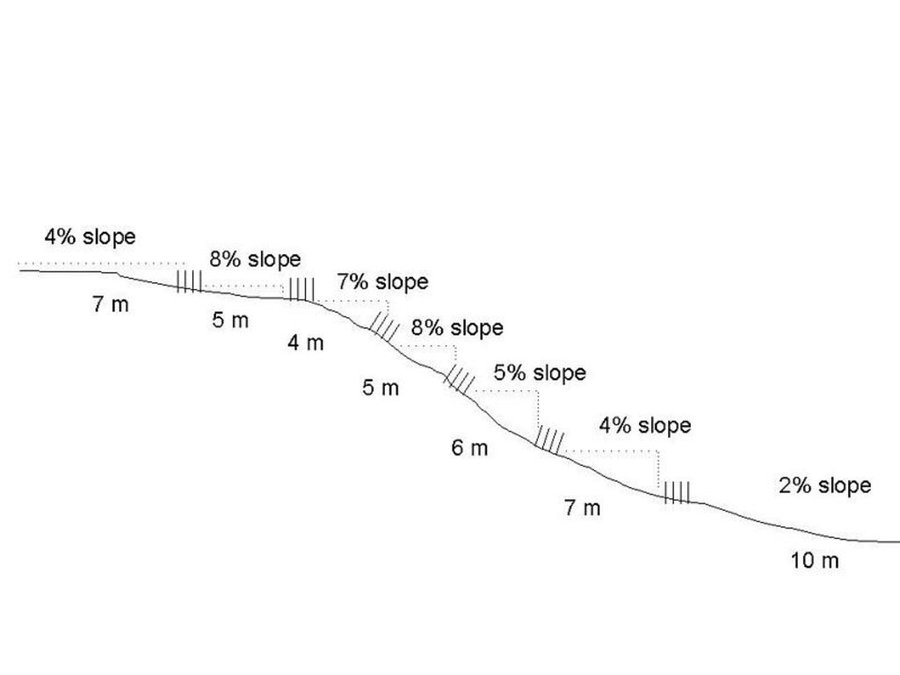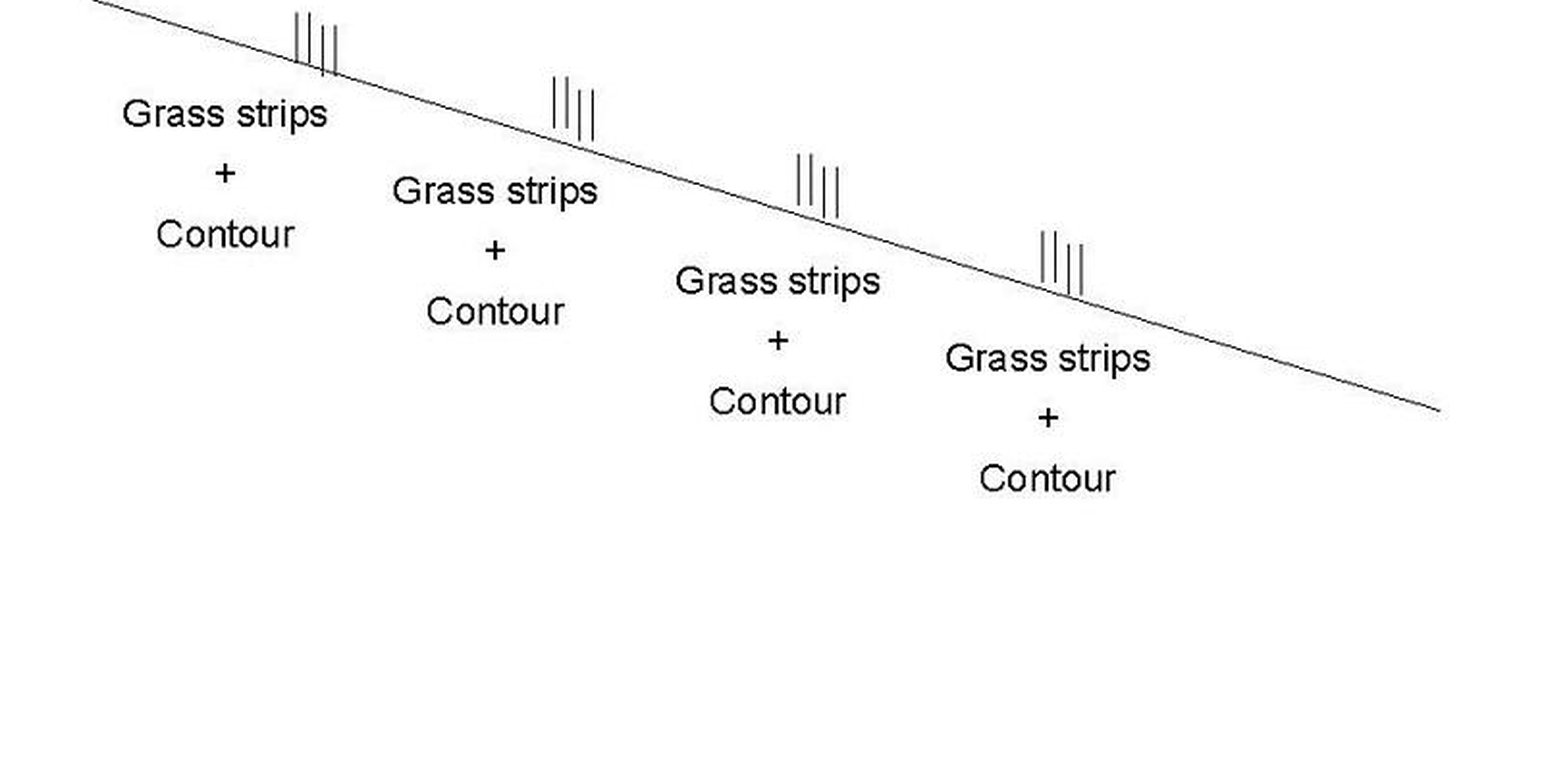Controlling of soil erosion during crop production
(South Africa)
Description
The technology that applies contouring, mulching and intercropping in SWC.
Agronomic technology is used to control soil erosion during the crop production period, i.e. method that is employed to improve soil fertility, conserve water and protect from soil erosion while the land is under crop production.
Purpose of the Technology: The purpose is to keep the fertility of the soil stable by protecting the soil from soil erosion and water loss.
Establishment / maintenance activities and inputs: The establishment is either done by planting strong root crops in between cultivated areas, or leaving the soil uncultivated, with a mulch cover on the soil surface. This will be maintained by keeping the intercrop strong and healthy while using zero or minimum tillage without removal of left over material on the soil surface.
Location
![]()
Location: Sekhukuneland, Limpopo Province, South Africa
No. of Technology sites analysed:
Geo-reference of selected sites
Spread of the Technology: evenly spread over an area (10.0 km²)
In a permanently protected area?:
Date of implementation: less than 10 years ago (recently)
Type of introduction
-
through land users' innovation
-
as part of a traditional system (> 50 years)
-
during experiments/ research
-
through projects/ external interventions
Classification of the Technology
Main purpose
-
improve production
-
reduce, prevent, restore land degradation
-
conserve ecosystem
-
protect a watershed/ downstream areas – in combination with other Technologies
-
preserve/ improve biodiversity
-
reduce risk of disasters
-
adapt to climate change/ extremes and its impacts
-
mitigate climate change and its impacts
-
create beneficial economic impact
-
create beneficial social impact
-
Prevent water loss
Land use
-
Cropland
- Annual cropping: cereals - maize, legumes and pulses - beans, oilseed crops - groundnuts
Number of growing seasons per year: 1
Water supply
-
rainfed
-
mixed rainfed-irrigated
-
full irrigation
Purpose related to land degradation
-
prevent land degradation
-
reduce land degradation
-
restore/ rehabilitate severely degraded land
-
adapt to land degradation
-
not applicable
Degradation addressed
-
soil erosion by water - Wt: loss of topsoil/ surface erosion
SLM group
-
improved ground/ vegetation cover
-
minimal soil disturbance
SLM measures
-
agronomic measures - A7: Others
Technical drawing
Technical specifications
Technical drawing off slope
Location: Mahlanga. Northern Province
Technical knowledge required for field staff / advisors: moderate
Technical knowledge required for land users: moderate
Main technical functions: control of concentrated runoff: retain / trap, control of concentrated runoff: drain / divert

Author: Mokgwakgwe Mashatola
Establishment and maintenance: activities, inputs and costs
Calculation of inputs and costs
- Costs are calculated:
- Currency used for cost calculation: USD
- Exchange rate (to USD): 1 USD = n.a
- Average wage cost of hired labour per day: 6.00
Most important factors affecting the costs
The voluntary labour was at minimal, therefore labour affected the cost significantly.
Establishment activities
n.a.
Establishment inputs and costs
| Specify input |
Unit |
Quantity |
Costs per Unit (USD) |
Total costs per input (USD) |
% of costs borne by land users |
|
Labour
|
| Labour |
persons/day/ha |
100.0 |
6.0 |
600.0 |
10.0 |
|
Equipment
|
| Machine use |
ha |
1.0 |
200.0 |
200.0 |
|
|
Construction material
|
| Earth |
ha |
1.0 |
25.0 |
25.0 |
|
| Total costs for establishment of the Technology |
825.0 |
|
| Total costs for establishment of the Technology in USD |
825.0 |
|
Maintenance activities
-
Conventional tillage (Timing/ frequency: early in rainy season / once a year)
Maintenance inputs and costs
| Specify input |
Unit |
Quantity |
Costs per Unit (USD) |
Total costs per input (USD) |
% of costs borne by land users |
|
Labour
|
| Conventional tillage |
persons/day/ha |
20.0 |
6.0 |
120.0 |
|
| Total costs for maintenance of the Technology |
120.0 |
|
| Total costs for maintenance of the Technology in USD |
120.0 |
|
Natural environment
Average annual rainfall
-
< 250 mm
-
251-500 mm
-
501-750 mm
-
751-1,000 mm
-
1,001-1,500 mm
-
1,501-2,000 mm
-
2,001-3,000 mm
-
3,001-4,000 mm
-
> 4,000 mm
Agro-climatic zone
-
humid
-
sub-humid
-
semi-arid
-
arid
Specifications on climate
n.a.
Slope
-
flat (0-2%)
-
gentle (3-5%)
-
moderate (6-10%)
-
rolling (11-15%)
-
hilly (16-30%)
-
steep (31-60%)
-
very steep (>60%)
Landforms
-
plateau/plains
-
ridges
-
mountain slopes
-
hill slopes
-
footslopes
-
valley floors
Altitude
-
0-100 m a.s.l.
-
101-500 m a.s.l.
-
501-1,000 m a.s.l.
-
1,001-1,500 m a.s.l.
-
1,501-2,000 m a.s.l.
-
2,001-2,500 m a.s.l.
-
2,501-3,000 m a.s.l.
-
3,001-4,000 m a.s.l.
-
> 4,000 m a.s.l.
Technology is applied in
-
convex situations
-
concave situations
-
not relevant
Soil depth
-
very shallow (0-20 cm)
-
shallow (21-50 cm)
-
moderately deep (51-80 cm)
-
deep (81-120 cm)
-
very deep (> 120 cm)
Soil texture (topsoil)
-
coarse/ light (sandy)
-
medium (loamy, silty)
-
fine/ heavy (clay)
Soil texture (> 20 cm below surface)
-
coarse/ light (sandy)
-
medium (loamy, silty)
-
fine/ heavy (clay)
Topsoil organic matter content
-
high (>3%)
-
medium (1-3%)
-
low (<1%)
Groundwater table
-
on surface
-
< 5 m
-
5-50 m
-
> 50 m
Availability of surface water
-
excess
-
good
-
medium
-
poor/ none
Water quality (untreated)
-
good drinking water
-
poor drinking water (treatment required)
-
for agricultural use only (irrigation)
-
unusable
Is salinity a problem?
Occurrence of flooding
Characteristics of land users applying the Technology
Market orientation
-
subsistence (self-supply)
-
mixed (subsistence/ commercial)
-
commercial/ market
Off-farm income
-
less than 10% of all income
-
10-50% of all income
-
> 50% of all income
Relative level of wealth
-
very poor
-
poor
-
average
-
rich
-
very rich
Level of mechanization
-
manual work
-
animal traction
-
mechanized/ motorized
Sedentary or nomadic
-
Sedentary
-
Semi-nomadic
-
Nomadic
Individuals or groups
-
individual/ household
-
groups/ community
-
cooperative
-
employee (company, government)
Age
-
children
-
youth
-
middle-aged
-
elderly
Area used per household
-
< 0.5 ha
-
0.5-1 ha
-
1-2 ha
-
2-5 ha
-
5-15 ha
-
15-50 ha
-
50-100 ha
-
100-500 ha
-
500-1,000 ha
-
1,000-10,000 ha
-
> 10,000 ha
Scale
-
small-scale
-
medium-scale
-
large-scale
Land ownership
-
state
-
company
-
communal/ village
-
group
-
individual, not titled
-
individual, titled
Land use rights
-
open access (unorganized)
-
communal (organized)
-
leased
-
individual
Water use rights
-
open access (unorganized)
-
communal (organized)
-
leased
-
individual
Access to services and infrastructure
Impacts
Socio-economic impacts
Crop production
Maize production & legume crops improved in good seasons
production area (new land under cultivation/ use)
Ecological impacts
surface runoff
Quantity before SLM: 40
Quantity after SLM: 10
excess water drainage
More water entered the soil
soil cover
Not a priority in this case
soil loss
Quantity before SLM: 0.5
Quantity after SLM: 0
More soil was trapped
soil fertility
Less fertilisers was washed away
Off-site impacts
reliable and stable stream flows in dry season (incl. low flows)
downstream flooding (undesired)
Cost-benefit analysis
Benefits compared with establishment costs
Short-term returns
very negative
very positive
Long-term returns
very negative
very positive
Benefits compared with maintenance costs
Short-term returns
very negative
very positive
Long-term returns
very negative
very positive
Adoption and adaptation
Percentage of land users in the area who have adopted the Technology
-
single cases/ experimental
-
1-10%
-
11-50%
-
> 50%
Of all those who have adopted the Technology, how many have done so without receiving material incentives?
-
0-10%
-
11-50%
-
51-90%
-
91-100%
Number of households and/ or area covered
350 households cover 80 percent of the area stated
Has the Technology been modified recently to adapt to changing conditions?
To which changing conditions?
-
climatic change/ extremes
-
changing markets
-
labour availability (e.g. due to migration)
Conclusions and lessons learnt
Strengths: land user's view
-
Soil protection
How can they be sustained / enhanced? Involve land-users right from the beginning and allow them to run the SWC on their own
Strengths: compiler’s or other key resource person’s view
-
Control soil erosion effectively
How can they be sustained / enhanced? Involve land-users right from the beginning and allow them to run the SWC on their own
-
Conserve moisture
Weaknesses/ disadvantages/ risks: land user's viewhow to overcome
Weaknesses/ disadvantages/ risks: compiler’s or other key resource person’s viewhow to overcome
-
Implementation
Implement with the land users and allow the land users to own the technology
References
Reviewer
-
Alexandra Gavilano
-
David Streiff
Date of documentation: Feb. 9, 2011
Last update: June 21, 2019
Resource persons
-
Francis Mahlakoane - SLM specialist
-
Mokgwakgwe Boy Mashatola - SLM specialist
Full description in the WOCAT database
Documentation was faciliated by
Institution
- Dept. of Agriculture, Northern Province (Dept. of Agriculture, Northern Province) - South Africa
Project
Key references
-
Sustainable land use plan for Nebo-district: Department of Soil Science, University of the North








